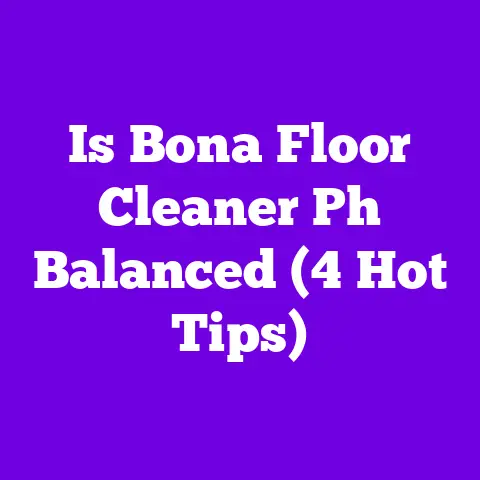How Long After Painting A Room Can You Mop It (Wait Time)
You know, with all the tech innovations
these days, painting a room has become a breeze.
From digital color matching to eco-friendly paints,
it’s amazing how far we’ve come. But once the walls
are painted, the big question is: when can you mop
the floors? Let’s dig into that.
The Science Behind Paint Drying and Curing
Before we talk about mopping, it’s essential to understand
what’s happening with the paint on your walls. Paint drying
and curing are two different stages. Drying is just the first
step where the solvent evaporates, leaving the paint dry to
the touch. However, curing involves a chemical reaction that
hardens the paint and gives it durability.
Types of Paint and Their Impact on Drying Time
- Latex Paint: Known for its quick drying properties, latex
paint typically dries to the touch within an hour or two. But
don’t be fooled; it can take up to 30 days to fully cure. - Oil-Based Paint: This type takes longer to dry, often
requiring 6-8 hours for drying and up to seven days for curing.
The high durability makes it worth the wait.
Factors Influencing Drying and Curing
- Humidity and Temperature: High humidity and low temperatures
slow down drying and curing. Ideally, you want a temperature of
about 70°F (21°C) and low humidity. - Ventilation: Proper airflow helps evaporate solvents faster,
speeding up drying.
Personal Experience: I remember using latex paint during a rainy
weekend. Despite being dry to the touch in a few hours, any attempt
to clean or mop was disastrous because the paint hadn’t cured fully.
Determining Readiness for Mopping
Understanding when you can safely mop is crucial to preserving
your newly painted walls and clean floors.
Conducting Tests
- Touch Test: Gently press your finger against the wall. If it
feels tacky or leaves a fingerprint, it’s not ready. - Odor Test: Paint smell lingering? It indicates ongoing curing.
- Color Consistency: Uneven color may mean incomplete curing.
- Hygrometer Use: Measure room humidity—ideal is below 50%.
Example Scenario: I once thought my walls were ready after two
days but noticed the paint smell was strong. Sure enough, mopping led
to streaks from the paint reacting with moisture.
Materials and Preparations for Mopping
Before mopping, gather these essentials:
- Microfiber Mop: Gentle on surfaces and prevents scratches.
- Bucket: Use two if possible; one for detergent solution, one for rinsing.
- Mild Detergent: Avoid harsh chemicals that may react with the paint.
- Clean Water: Essential for rinsing.
- Fans or Dehumidifiers: Help maintain low humidity and aid drying.
- Protective Gear: Gloves to protect your skin from cleaning agents.
Step-by-Step Mopping Process
Step 1: Prepare Your Cleaning Solution
Mix a mild detergent with warm water. Ensure it’s well-diluted
to avoid leaving residue on floors.
Step 2: Wring Out the Mop
Ensure your mop is damp, not soaking wet. Excess water can seep into baseboards or damage uncured paint.
Step 3: Start Mopping
Begin at the farthest corner from the exit. This way, you won’t walk
over freshly cleaned areas.
Step 4: Rinse Frequently
Rinse the mop often to prevent spreading dirt or potential paint residue.
Step 5: Allow Drying
Open windows or use fans to speed up the drying process.
Helpful Tips and Warnings
- Tip: Use a mop with removable pads for easy cleaning and maintenance.
- Warning: Avoid using steam mops—heat can damage uncured paint.
- Tip: Employ fans to enhance airflow and reduce drying time.
- Warning: Check corners where paint might have dripped; moisture can cause peeling.
Common Mistakes and How to Avoid Them
Mopping too soon is a common error. Even if walls feel dry,
the underlying layers may not be cured. Be patient!
Mistake 1: Ignoring Humidity Levels
High humidity can dramatically slow curing times. Always check conditions before deciding it’s time to mop.
How to Avoid: Use a dehumidifier or wait for drier conditions.
Mistake 2: Using Harsh Cleaners
Harsh chemicals can dull the finish or even strip away fresh paint.
How to Avoid: Stick with mild detergents specifically designed for painted surfaces.
Mistake 3: Over-Saturating the Floor
Too much water can seep into seams, leading to warping or damage.
How to Avoid: Always wring out your mop thoroughly before each swipe.
Proper Cleanup and Finishing Procedures
After mopping, clean your tools immediately. Rinse your mop thoroughly to remove any detergent residues that could harden over time. Store your cleaning supplies in a dry area to prevent mold or mildew growth.
Safety Considerations
When dealing with post-painting cleanup, safety is key:
- Ventilation: Always ensure good airflow when using cleaning solutions.
- Protective Gear: Wearing gloves can prevent irritation from cleaning agents.
- Slip Hazards: Be mindful of wet floors which can be slippery; use signs or cones if necessary.
Extended Stories and Insights
Story Time: A Lesson Learned the Hard Way
I remember this one time—after painting a client’s office—I was eager to finish up and mop the floors quickly. The paint was dry to touch, but I didn’t account for the air conditioning that had been running non-stop. It created an illusion of dryness due to the cool air circulating. When I mopped, I noticed streaks forming where there shouldn’t have been any. Turned out, the AC had slowed down the curing process significantly. So now, I always make sure ventilation is appropriate and natural whenever possible!
Exploring Different Flooring Surfaces
Different flooring types demand unique care post-painting:
Wooden Floors
Excess moisture can warp wood, so ensure mops are only damp. Also, consider using pH-neutral cleaners specifically for wood surfaces.
Concrete Floors
Concrete is porous, so fully cured paint is critical before mopping. Sealants can be applied after curing to protect both paint and floor.
Tile Floors
Tiles are durable but grout lines can absorb moisture. Clean thoroughly but avoid excessive water pooling around edges.
Advanced Tips for Enthusiasts
If you’re really into home improvement like I am, you might appreciate these advanced tips:
- Use a Paint Curing Fan:
- These fans are specifically designed to accelerate curing times by promoting airflow without disrupting paint integrity.
- Eco-Friendly Solutions:
- Consider using biodegradable detergents which are gentle on both surfaces and the environment.
- Sealing Painted Surfaces:
- Once fully cured, use a sealant to add an extra layer of protection against stains and moisture.
Why Patience Pays Off
While waiting might seem tedious when you’re excited about your newly painted space, trust me—it pays off! Rushing leads to mishaps that can ruin your hard work and cost more time in repairs down the line.
Additional Personal Anecdotes
I’ve had my fair share of painting projects over the years. One memorable incident involved painting my own kitchen right before hosting a family gathering. In my haste to get everything ready, I ignored my own advice about waiting for the paint to cure fully before cleaning up. Needless to say, mopping too early left unsightly streaks that were hard to fix in time for my guests!
In-depth Look at Tools & Equipment
Getting the right tools makes all the difference:
Q: What if paint smudges while mopping?
A: Stop immediately! Allow additional drying time before attempting again—usually another 24-48 hours.
Q: Can I mop with hot water?
A: Warm water is fine; boiling hot water might affect uncured paint adversely by softening it unexpectedly!
Q: Is it okay to mop painted concrete floors?
A: Absolutely—just ensure they’re fully cured as concrete’s porosity requires extra caution during initial cleanings post-painting!
Q: How do I speed up curing time naturally?
A: Increase ventilation naturally by opening windows or doors; consider using fans strategically placed around painted areas too!
Now you’re armed with everything you need for a smooth transition from painting blissfully new walls into maintaining pristine floors beneath them! Got more questions? Reach out anytime—I’m always here ready for another chat!






